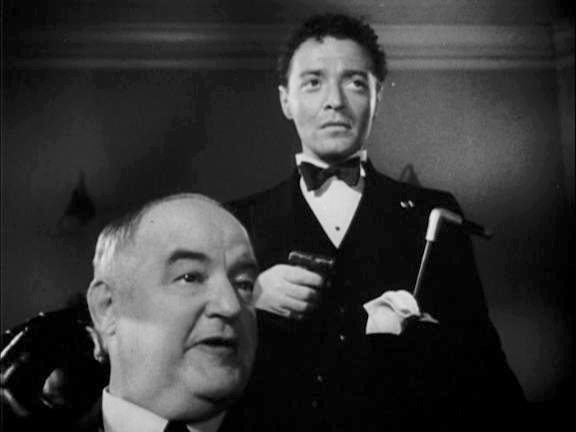 Dashiell Hammet’s “blonde satan” Sam Spade is an icon of not only 20th-century literature but also 20th-century cinema, thanks in part to Humphrey Bogart and John Huston. He’s the cynical, hard-nosed, unsentimental P.I. whose general unpredictability sometimes leads to angry outbursts and other times gleeful amusement. He’s a straight talker and not about to be pushed around. If this sounds familiar at all, it’s because it lays the prototypical foundation for any film noir gumshoe ever. Except Bogart’s Spade receives the credit as the archetype. All other portrayals whether homage or parody stem from his performance. And it is quite the performance, but he has some worthy adversaries attempting to upstage him.
Dashiell Hammet’s “blonde satan” Sam Spade is an icon of not only 20th-century literature but also 20th-century cinema, thanks in part to Humphrey Bogart and John Huston. He’s the cynical, hard-nosed, unsentimental P.I. whose general unpredictability sometimes leads to angry outbursts and other times gleeful amusement. He’s a straight talker and not about to be pushed around. If this sounds familiar at all, it’s because it lays the prototypical foundation for any film noir gumshoe ever. Except Bogart’s Spade receives the credit as the archetype. All other portrayals whether homage or parody stem from his performance. And it is quite the performance, but he has some worthy adversaries attempting to upstage him.
Brigid O’Shaughnessy (Mary Astor) is the conniving, beguiling, lying little stagy siren who comes into his office in need. She sets a precedent with a string of lies and that never ceases. However, there are half-truths and bits of genuineness backed by her quivering voice and pleading eyes. It took another round to realize what a femme fatale she actually is because she is in fact so good at it. You almost don’t realize how deadly she could be. And in the pantheon of femme fatales, I admittedly forget her in deference to the likes of Phyllis Dietrichson, Gilda, or Kitty Collins. Perhaps Spade’s a little stronger than most protagonists, a little more resilient, not allowing himself to be completely duped. But from the get-go, Brigid has him reeling and guessing. The difference is that he knows it. It’s not until the very end however, that’s he’s finally able to get an actual line on her.
 Then there’s Joel Cairo played so cunningly by the always wily and beady-eyed Peter Lorre and Kaspar Gutman portrayed so assertively and pointedly by the perennially memorable Sidney Greenstreet. These two men would come back in Casablanca and numerous other Warner Bros. Pictures, but they are the epitome of iconic characters actors who make any narrative that much more interesting. They have mugs and physiques really made for the dark recesses of the noir world, and when you put these four together it does spell trouble. Add a quietly seething Elisha Cook Jr. as Wilmer, the always personable Ward Bond as a Police Detective, and Lee Patrick as Spade’s doll of a secretary and you have a true winner.
Then there’s Joel Cairo played so cunningly by the always wily and beady-eyed Peter Lorre and Kaspar Gutman portrayed so assertively and pointedly by the perennially memorable Sidney Greenstreet. These two men would come back in Casablanca and numerous other Warner Bros. Pictures, but they are the epitome of iconic characters actors who make any narrative that much more interesting. They have mugs and physiques really made for the dark recesses of the noir world, and when you put these four together it does spell trouble. Add a quietly seething Elisha Cook Jr. as Wilmer, the always personable Ward Bond as a Police Detective, and Lee Patrick as Spade’s doll of a secretary and you have a true winner.
With the eponymous blackbird to drive the plot all you really need are these characters and their inherent greed to pull them along. The beauty is that we do not know the details, but following Spade we slowly have piece after piece revealed, character after character make their entrance until everyone’s together and things get interesting
The story has loads of substance built-in and Huston was absolutely meticulous with his preparation for the film script and otherwise, which paid heavy dividends in the end. Hardly anything seems throw away and all the dialogue and scenes flow in a wonderfully seamless way that continues to carry us along in anticipation. It’s so engaging in fact that it becomes quite easy to disregard the film’s astute cinematography utilizing low-key lighting, which would become a norm for noir and then low angles that are reminiscent of another film that came out that same year, Citizen Kane.
Modern viewers might well accuse this film of being overly talkie, but amidst its iconic characterizations and bewildering plot, there are immeasurable pleasures to be mined. Few people would contest that the Maltese Falcon really is a major benchmark in film, as not only the early beginnings of German-influenced American melodramas (aka film-noir) but also a major career boost for the up and coming Huston, not to mention the veteran character actor Bogart. For film-noir lovers or cinephiles in general, this truly is the stuff that dreams are made of. John Huston and Bogart would both come back with success, after success, after success, but there’s something to be said for where it all began. The Maltese Falcon is a treasure indeed.
5/5 Stars

Pingback: Classic Movie Beginner’s Guide: 1940s Film Noir | 4 Star Films
Pingback: Classic Movie Beginner’s Guide: John Huston | 4 Star Films
Pingback: Peter Lorre: Stranger on The Third Floor, Mask of Dimitrios, The Verdict | 4 Star Films
Pingback: Bette Davis: In This Our Life, Now, Voyager, Mr. Skeffington | 4 Star Films
Pingback: Christmas in Connecticut (1945): Yuletide Cheer and The War’s End is Here | 4 Star Films